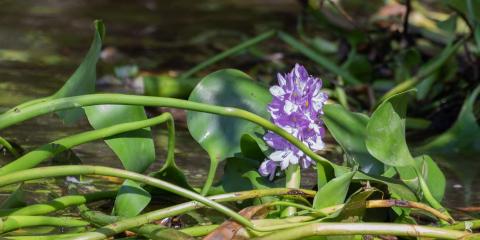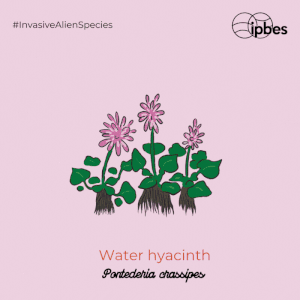
#InvasiveAlienSpecies
In 2023, IPBES published the Thematic Assessment of Invasive Alien Species and their Control — the largest study ever of its kind. Invasive alien species are one among the five direct drivers of biodiversity loss.
How can we address this threat? How can you and your community rise to the challenge?
Keep reading for an overview of IPBES resources on invasive alien species, ways in which you can take action, and further opportunities for learning and engagement — all available for free.
Last updated 17 December 2024 (new content was added; earlier links were not checked at this time)

Get high-quality science from IPBES
Learn about the state of invasive alien species around the world, and options to control them:
- Factsheets:
For a quick glimpse, see the factsheets. The expert co-chairs and technical support unit have selected information on seven key areas.
- Summary:
For an accessible overview, see the summary for policymakers. This was approved by the IPBES Plenary (the platform's governing body) at the 10th plenary session. The summary is also available in Arabic (عر ب), Chinese (中文), French (français), Russian (русский), and Spanish (español).
- Full report:
For the full scientific review, see the Thematic Assessment Report on Invasive Alien Species and their Control. Alternatively, download individual chapters from the IPBES website; the website also contains the review comments, glossary, and bibliography.
- E-learning:
IPBES has prepared a special e-learning page that guides you through the Invasive Alien Species assessment report. You might want to start with the introductory video.
- Knowledge gaps:
For a list of the knowledge gaps identified by the assessment, search the IPBES database. Each entry will guide you to corresponding chapters, sections and pages of the assessment report. If you missed the IPBES webinar introducing the database, you can download the slides (5.16 MB).
Please also see the Assessment Directories on the IAS Assessment: the IPBES Technical Support Unit for data and knowledge management has listed all documents related to the assessment report.
Explore more #InvasiveAlienSpecies materials
- Watch
and share the report's video summary on @ipbeschannel.
Subtitles are available in Arabic, Chinese, French, German, Russian, and Spanish.
You might also be interested in the trailer, available in English, Spanish, and French.
Or join Assessment Coordinator Tanara Renard Truong Van Nga for a backstage tour of the assessment process.
- Listen
to Aliens on Your Doorstep: Invasive Species and You: the 5th episode, 3rd season, of the popular Nature Insight podcast.
- And show your awareness:
Get your copy of the IPBES invasive species poster. Choose your #InvasiveAlienSpecies video conferencing background: alongside stunning nature photography, several drawings on this page are available.
You might also want to check out the media release: it includes a shorter and a longer presentation, and key tables. The media release is also available in Spanish, French, and Japanese. For details, watch the full recording of the media launch, including the presentation by the co-chairs and a media Q&A.
Select related external publications
Some of the IPBES assessment report's experts have co-authored subsequent publications, for example:
- Schwindt, August, Vanderhoeven et al. (2024) Overwhelming evidence galvanizes a global consensus on the need for action against Invasive Alien Species, Biological Invasions 26, 621–626, DOI 10.1007/s10530-023-03209-x
- Henriksen et al. (2024) Global indicators of the environmental impacts of invasive alien species and their information adequacy, Philosophical Transactions of the Royal Society B 379, 20230323, DOI 10.1098/rstb.2023.0323
- Roy, Pauchard, Stoett et al. (2024) Curbing the major and growing threats from invasive alien species is urgent and achievable, Nature Ecology & Evolution, DOI 10.1038/s41559-024-02412-w
Indigenous and local knowledge of invasive alien species
At least a quarter of the global land area is traditionally owned, managed, used or occupied by Indigenous Peoples. These peoples and local communities often maintain and enhance biodiversity. They are also directly impacted by the drivers of biodiversity loss. IPBES works closely with these groups in all its assessments, including this one:
- Relevant key messages from the assessment in English, French and Spanish (approx. 5 MB).
- See the recording of the webinar from 29 May 2024 in English, French or Spanish.
- Reports from dialogues with indigenous peoples and local communities:
Select related external publications
- A report submitted for consideration in the assessment by the Centers of Distinction on Indigenous and Local Knowledge:
Cariño et al. (2022) Indigenous Peoples and Local Communities Perspectives and Experiences on Invasive Alien Species, COD-ILK & PIKP, Baguio City, Philippines, ISBN 978-621-96453-3-1. (25.2 MB)
- Posters by BES Net on 'Indigenous Peoples and Local Communities and the Management and Control of Invasive Alien Species,' based on the assessment report.
- A data analysis that draws on and complements the assessment report:
Seebens, Niamir, Essl et al. (2024) Biological invasions on Indigenous peoples’ lands, Nature Sustainability, DOI 10.1038/s41893-024-01361-3.

Support the uptake of the Invasive Alien Species Assessment
Base your community project on a solid science foundation. Help others get the best available evidence on invasive alien species and their control.
IPBES is inviting us to support and use the key findings of the Invasive Alien Species Assessment. You can help by organizing events or creating materials that enhance understanding of its vital findings.
- Get inspired:
See the section below on others' invasive alien species events. Or see others' contributions to capacity-building related to earlier IPBES assessments.
- Showcase your work:
Report your activity to the IPBES Plenary, with its 145 member governments. Simply register your contribution by 30th June 2024.
- Share your achievement:
Have you or your organisation successfully used an IPBES product like the Invasive Alien Species Assessment? For example in decision-making, research, or a project? IPBES tracks these impacts publicly. You are warmly invited to add your work to the IPBES Impact Tracking Database (TRACK).
Helpful contacts
- Email the IPBES Secretariat
for hardcopies of the summary for policymakers or the full report, introductions to relevant IPBES experts for your event or project, or IPBES promotion materials.
- Email the technical support unit on capacity-building
to receive further information about the types of support that the IPBES secretariat could possibly offer to such events, or to ask questions about the work on capacity-building under the auspices of IPBES.
- Email the ONet facilitation team
to discuss your project and help answer any questions. Remember to share your event among the ONet community on our events page.

Attend a free event on invasive alien species
On the ONet events page, we share events on biodiversity and nature's contributions to people from around the world. Most take place online: available to everyone, anywhere, for free.
As an ONet member, you are also warmly invited to add an event.
Events on invasive alien species (co-)organised by IPBES
- 29 May 2024 – Indigenous Peoples and local communities (IPLCs) in the IPBES assessment of Invasive Alien Species and their Control.
Watch the recording in English, French or Spanish. Also see the separate section on this page above.
- 11 Mar 2024 – Knowledge gaps on Invasive Alien Species.
Download the webinar slides (5.16 MB).
- 24 Nov 2023 – Join the ONet Caucus.
Download the interactive slides (6.85 MB).
- 05 Oct 2023 – International Webinar on Invasive Alien Species (featuring IPBES experts).
Watch the recording and download the summary.
- 04 Oct 2023 – Webinar on the IPBES Invasive Alien Species Assessment (featuring an IPBES expert).
Watch the recording.
External events on invasive alien species
- 18 Apr 2024 – The management of invasive alien species in Finland, Sweden and Norway.
- 17 Apr 2024 – Field mapping protocols for invasive plant species.
- 08 Apr 2024 – Invasive alien species in Asia and Oceania and measures for them, part of the 6th Science Policy for Biodiversity Forum online sessions.
- 07 Mar 2024 – Invasive Species ID & Management.
- 27 Feb 2024 – The Invasive Species Language Workshop.
- 15 Feb 2024 – Friend or Foe? How to Identify Invasive Plants in Our Backyards.

Take a free course on invasive alien species
In our e-learning catalogues, we collect online learning opportunities — especially MOOCs — on biodiversity and nature's contributions to people. All of them are available for free. Check out these offers on invasive alien species:
- Have you seen an alien?
"This course aims at raising awareness, increasing knowledge and involving the public in monitoring invasive alien species (IAS) in Europe, promoting people’s engagement in IAS management, and supporting the implementation of the EU Regulation 1143/2014 on IAS." Receive a free certificate upon successful completion. Available in multiple EU languages.
- Introduction to Invasive Species Online Training.
"The goal of the course is to increase the awareness and implementation of responsible actions related to invasive species prevention and management by government staff, contractors, and volunteers working on provincial public lands." Receive a free downloadable certificate upon passing a quiz.
- eLearning course catalogue of the Invasive Species Council of BC.
While these courses draw on examples from British Columbia, Canada, some are relevant to a wider audience: for example, an introduction to invasive alien species and training on community science. Furthermore, training for pet owners, gardeners, forestry practitioners and professionals, land use professionals, tourism professionals, marina operators and staff, anglers, and seaplane operators.
- Species conservation.
"The MOOC’s goal is [...] to introduce the notion of species, what they represent within a protected area's heritage, how managers conserve them, what the best conditions are, the limits, the opportunities, how can they be used to improve PA results and so on." Includes chapters on plant and animal invasive species. Receive a free certificate of success upon achieving a minimum grade. Also available in French.
- Marine protected areas.
Covers MPA definition and key concepts; planning of MPAs; management, governance, funding and valorisation; management, enforcement and reporting; MPAs and marine biodiversity; The future of MPAs: perspective and opportunities. Includes a chapter on MPAs and invasive species. Receive a free certificate of success upon achieving a minimum grade. Also available in French.
Obviously, invasive alien species vary by geographic region. The courses listed above were selected to be relevant to as many people as possible. You may also want to search online for available training specific to your area.
Do you have ideas, questions, or plans?
The ONet faciliation team would love to hear from you! Email us at any time, or watch the ONet newsletter for upcoming ONet Caucus events.

Hero photo
by lauriedkr/iNaturalist: The Water Hyacinth (Pontederia crassipes, formerly Eichhornia crassipes) is the most widespread invasive alien species worldwide. Infestations of these plants can block waterways, boat traffic, and swimming; they can also destroy and pollute aquatic ecosystems. Water hyacinths feature on the cover of the IPBES invasive alien species assessment report.
